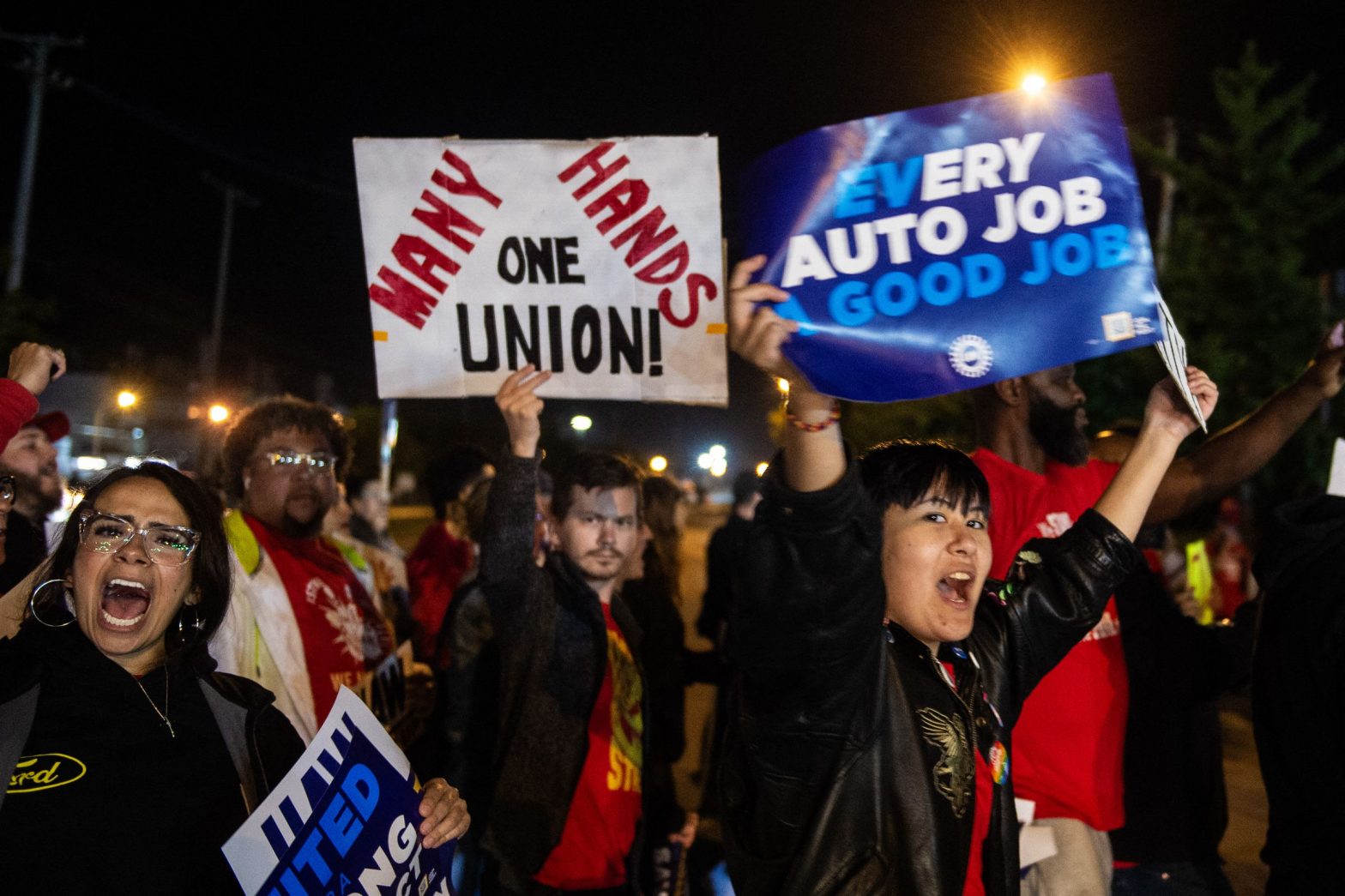/
Workers at Ford, GM, and Stellantis factories walked off the job, throwing a wrench into the industry’s multibillion-dollar plan to catch up to Tesla.
Share this story
:format(webp)/cdn.vox-cdn.com/uploads/chorus_asset/file/24924305/1667285458.jpg)
At midnight on Friday, the United Auto Workers (UAW) went on strike, imperiling the “Big Three” automakers’ plans to spend billions of dollars on electric vehicles in a bid to catch up to Tesla.
It was a historic moment — never before had workers at all three companies gone on strike at the same time — that came as the automakers were in the midst of making a huge high-stakes switch to EVs.
Those plans are now on hold, as Ford, General Motors, and Stellantis workers take to the streets to demand a share of the profits generated by combustion trucks and SUVs as well as stronger job security and better retirement plans.
The UAW stuck to its plans for a targeted walkout to start. Workers at three plants — GM’s Wentzville, Missouri, assembly, Stellantis’ Toledo, Ohio, assembly complex, and Ford’s Wayne, Michigan, assembly plant — were the first to go on strike. UAW president Shawn Fain said the union would hold off on a more costly national walkout for now, but it’s still on the table if contract negotiations don’t progress.
Ford said it got a counterproposal from the union hours before the current contract expired but said there was “little movement” from the UAW’s previous proposal.
:format(webp)/cdn.vox-cdn.com/uploads/chorus_asset/file/24924530/1668202374.jpg)
“If implemented, the proposal would more than double Ford’s current UAW-related labor costs, which are already significantly higher than the labor costs of Tesla, Toyota and other foreign-owned automakers in the United States that utilize non-union-represented labor,” Ford said in a statement.
GM CEO Mary Barra noted that the two sides were still far apart on key issues. “We still have a ways to go with the offer they put on the table last night,” Barra said on CBS This Morning on Friday.
Analysts note that the Big Three spend roughly $64–$67 an hour on total labor costs, including benefits, while their nonunion rivals only spend around $55 an hour and Tesla spends $45–$50 an hour.
But the union notes that all three automakers have pulled in record profits in recent years — a combined $21 billion in just the first six months of 2023, according to UAW — and the workers now want their fair share.
Analysts were split on the economic impact of the strike, with some calling it symbolic and others devastating. The struck plants produce some of the automakers’ most profitable models, including the Ford Bronco, the Jeep Wrangler, and the Chevy Colorado pickup.
“This is more of a symbolic strike than an actual damaging one,” Sam Fiorani, a production forecaster at AutoForecast Solutions, told Reuters. But not everyone was in agreement.
“Lets be clear: this is a potential nightmare situation for GM and Ford as both 313 stalwarts are in the early stages of a massive EV transformation path for the next decade that will define future success,” said Dan Ives of Wedbush. He added that the “clear winner was… Musk and Tesla with champagne now on ice.”
Tesla operates its Fremont, California, factory with nonunion labor, as the UAW has struggled to find a toehold at the plant. The company has also been accused of violating labor law by the National Labor Relations Board for barring workers from discussing pay and working conditions. And there have been many OSHA (Occupational Safety and Health Administration) complaints filed against Tesla over the years.
Ives, who is bullish on Tesla, predicted that a prolonged strike could push the Big Three automakers to agree to major increases in labor costs, which could then be passed along to the consumer.
“The big issue for GM and Ford as well as investors is around if anywhere near a ~40% wage increase gets approved/agreed this will be a major headwind on the cost front and ultimately in some way be passed down to the consumer and thru EV prices,” he wrote in a research note. “The costs of EV vehicles out of Detroit is a major advantage going after mass adoption with any $3k, $5k, $7k, etc added to the slew of vehicles coming out would results in demand churn in our opinion.”
But the workers say they can’t afford a middle-class life, much less a brand-new vehicle from the plants where they work, without a fair contract.
“People are angry,” Brandon Szcesniak, a 21-year-old union member who works at Ford’s Wayne plant, told Labor Notes. “It’s like a revolving door. it’s not a career anymore, it’s a job. They want us to buy Fords, but how can we buy a Ford on this pay?”
